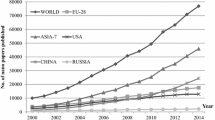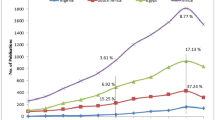Abstract
This paper analyses the growth pattern of Nanoscience and Nanotechnology literature in India during 1990–2009 (20 years). The Scopus international multidisciplinary bibliographical database has been used to identify the Indian contributions on the field of nanoscience and nanotechnology. The study measures the performance based on several parameters, country annual growth rate, authorship pattern, collaborative index, collaborative coefficient, modified collaborative coefficient, subject profile, etc. Further the study examines national publication output and impact in terms of average citations per paper, international collaboration output and share, contribution and impact of Indian Institutions and impact of Indian journals.



Similar content being viewed by others
References
Ajiferuke, I., Burell, O., & Tague, J. (1988). Collaborative coefficient: A single measure of the collaboration in research. Scientometrics, 14, 421–433.
Alonso, S., et al. (2010). hg-index: A new index to characterize the scientific output of researchers based on the h- and g-indices. Scientometrics, 82, 391–400. doi:10.1007/s11192-009-0047-5.
Bassecoulard, E., Lelu, A., & Zitt, M. (2007). Mapping nanosciences by citation flows: A preliminary analysis. Scientometrics, 70(3), 859–880.
Bhattacharya, S., & Nath, P. (2002). Using patent statistics as a measure of “technologies assertiveness”? A China-India comparison. Current Science, 83(1), 23–29.
Braun, T., Schubert, A. P., & Zsindely, S. (1997). Nanoscience and nanotechnology on the balance. Scientometrics, 38(2), 321–325.
Chen, H., & Roco, M. C. (2009). Mapping nanotechnology innovations and knowledge (p. 330). New York, USA: Springer.
Egghe, L. (2006). Theory and practice of the g-index. Scientometrics, 69(1), 131–152.
Franks, A. (1987). Nanotechnology. Journal of Physics E: Scientific Instruments, 20, 1442–1451.
Garg, K. C., & Pandhi, P. (1999). Scientometrics of laser research literature as viewed through, Journal of Current Laser Abstracts. Scientometrics, 45, 19–38.
Garg, K. C., et al. (2009). Bibliometrics of global malaria vaccine research. Health Information and Libraries Journal, 26, 22–31.
Glanzel, W., Meyer, M., Du Plessis, M., Thijs, B., Magerman, T., Schlemmer, B., et al. (2003). Nanotechnology: Analysis of an emerging domain of scientific and technological endeavour. Katholieke Universiteit Leuven: Steupunt O&O Staisitieken.
Hirsch, (2005). An index to quantify an individual’s scientific research output. Proceedings of National Academic Science, USA, 102(46), 16569–16572.
Huang, Z., Chen, H., Chen, Z. K., & Roco, M. (2004). International nanotechnology development in 2003; country, institution and technology field analysis based on USPTO patent database. Journal of Nanoparticle Research, 6(4), 325–354.
Huang, M. H., Chiang, L. Y., & Chen, D. Z. (2003). Constructing a patent citation map using bibliographic coupling: A study of Taiwans high-tech companies. Scientometrics, 58(3), 458–489.
Hullmann, A. (2007). Measuring and assessing the development of nanotechnology. Scientometrics, 70(3), 739–758.
Hullmann, A., & Meyer, M. (2003). Publications and patents in the nanotechnology: An overview of previous studies and the state of the art. Scientometrics, 58(3), 507–527.
Igami, M. (2008). Exploration of the evolution of nanotechnology via mapping of patent applications. Scientometrics, 77(2), 289–308.
Kostoff, R. N., Koytcheff, R. G., & Lau, C. G. Y. (2007). Global nanotechnology research metrics. Scientometrics, 70(3), 565–601.
Kostoff, R. N., Stump, J. A., Johnson, D., Murday, J. S., Lau, C. G. Y., & Tolles, W. M. (2006). The structure and infrastructure of the global nanotechnology literature. Journal of Nanoparticle Research, 8(3), 301–321.
Lawani, S. M. (1980). Quality, collaboration and citations in cancer research: A 268 bibliometric study. Ph.D. Dissertation, Florida State University, 395 pp.
Leydesdorff, L. (2008). The delineation of nanoscience and nanotechnology in terms of journals and patents: A most recent update. Scientometrics, 76(1), 159–167.
Leydesdorff, L., & Zhou, P. (2007). Nanotechnology as a field of science: Its delineation in terms of journals and patents. Scientometrics, 70(3), 693–713.
Li, X., Chen, H., Dang, Y., Lin, Y., Larsen, C. A., & Roco, M. C. (2008). A longitudinal analysis of nanotechnology literature 1976–2994. Journal of Nanoparticle Research, 10, 3–22.
Lin, M.-W., & Zhang, J. (2007). Language trends in nanoscience and technology: The case of Chinese-language publications. Scientometrics, 70(3), 555–564.
Liu, X., et al. (2009). Trends for nanotechnology development in China, Russia and India. Journal of Nanoparticle Research, 11, 1845–1866.
Mahapatra, M. (1985). On the validity of the theory of exponential growth of scientific literature. In 15th IASLIC conference proceedings, Bangalore, IASLIC, pp 61–70.
Meyer, M. (2000a). Patent citations in a novel field of technology—what can they tell about interactions between emerging communities of science and technology? Scientometrics, 48(2), 151–178.
Meyer, M. (2000b). Does science push technology? Please citing scientific literature. Research Policy, 29(3), 409–434.
Meyer, M. (2000c). What is special about patent citations? Differences between scientific and patent citations. Scientometrics, 49(1), 93–123.
Meyer, M. (2001). Patent citation analysis in a novel field of technology: An exploration of nanoscience and nanotechnology. Scientometrics, 51(1), 163–183.
Meyer, M. (2007). What do we know about innovation in nanotechnology? Some propositions about an emerging field between hype and path dependency. Scientometrics, 70(3), 779–810.
Meyer, M., & Persson, O. (1998). Nanotechnology-interdisciplinarity, patterns of collaboration and differences in application. Scientometrics, 42(2), 195–205.
Meyer, M., Persson, O., & Power, Y. (2001). Nanotechnology expert group and eurotech data mapping excellence in nanotechnologies, EC, DG-research, Preparatory study.
Mithal, R., Ahmad, M., & Singh, G. (2005). Citation mapping of published literature on Embelia ribes. Annals of Library and Information Studies, 52(4), 308–316.
Mohan, L., Prakasan, E. R., Kademani, B. S., Surwase, G., Kumar, A., & Kumar, V. (2010). Research trends in nanoscience and nanotechnology in India. DESIDOC Journal of Library and Information Technology, 30(2), 40–58.
Nagpaul, P. S. (1995). Contribution of Indian universities to the mainstream scientific literature, a bibliometric assessment. Scientometrics, 32, 11–36.
Noyons, E. C., Buter, R. K., Hinze, S., Van Raan, A. F. J., Schmoch, U., Heinze, T., & Rangnow, R. (2003). Mapping excellence in science and technology across Eruope: Nanoscience and Nanotechnology, EC, EC-PPN, CT 2002-0001.
Parr, D. (2005). Will nanotechnology make the world a better place? Trends in Biotechnology, 23(8), 395–398.
Pavitt, K. (1998). Do patents reflect the useful output of universities? Research Evaluation, 7(2), 105–111.
Pouris, A. (2007). Nanoscale research in South Africa: A mapping exercise based on scientometrics. Scientometrics, 70(3), 541–553.
Prathap, G. (2010). The 100 most prolific economists using the p-index. Scientometrics, 84, 167–172. doi:10.1007/s11192-009-0068-0.
Prathap, G., & Gupta, B. M. (2009). Ranking of Indian engineering and technological institutes for their research performance during 1999–2008. Current Science, 97(3).
Radrigo, Costas., & Maria, Bordons. (2008). Is g-index better than h-index? An exploratory study at the individual level. Scientometrics, 77(2), 267–288.
Rajeswari, A. R. (1996). Indian patent statistics: An analysis. Scientometrics, 36(1), 109–130.
Retrieved from Scopus Info Site on March 2, 2010 http://info.scopus.com.
Roco, M. C. (2001). International strategyfor nanotechnology research. Journal of Nanoparticle Research, 3(5–6), 353–360.
Sangeetha, M. A., Chakrabarti, S., & Amba, S. (1999). Indian leather patents: An analysis. World Patent Information, 21(2), 69–73.
Savanur, K., & Srikanth, R. (2010). Modified collaborative coefficient: A new measure for quantifying the degree of research collaboration. Scientometrics, 84, 365–371. doi:10.1007/s11192-009-0100-4.
Schreiber, M. (2008). The influence of self-citations corrections on Egghe’s g-index. Scientometrics, 76(1), 187–200.
Schultz, L. I., & Joutz, F. L. (2009). Methods for identifying emerging general purpose technologies: A case study of nanotechnologies. Scientometrics. doi:10.1007/s11192-010-0244-2.
Schummer, J. (2004). Multidisciplinarity, interdisciplinarity and patterns of research collaboration in nanoscience and nanotechnology. Scientometrics, 59(3), 425–465.
Schummer, J. (2007). The global institutionalization of nanotechnology research: A bibliometric approach to the assessment of science policy. Scientometrics, 70(3), 669–692.
Subramanyam, K. (1983). Bibliometric studies of research collaboration: A review. Journal of Information Science, 6, 33–38.
Takeda, Y., et al. (2009). Nanobiotechnology as an emerging research domain from nanotechnology: A bibliometric approach. Scientometrics, 80(1), 23–38.
Tol, R. S. J. (2009). The h-index and its alternatives: An application to the 100 most prolific economists. Scientometrics. doi:10.1007/s/11192-008-2079-7.
Wilson, C. S. (2001). Informetrics, In M. E. Williams (Ed.), Annual Review of Information Science and Technology, 34, Medford NJ: Information Today, Inc. for the American Society for Information Science, pp. 3–143.
Wilson, M., Kannangara, K., Smith, G., Simmons, M., & Raguse, B. (2002). Nanotechnology: Basic science and emerging technologies. Boca Raton, FL: Chapman and Hall/CRC Press.
Zitt, M., & Bassecoulard, E. (2006). Delineating complex scientific fields by an hybrid lexical-citation method: An application to nanosciences. Information Processing & Management, 42(6), 1513–1531.
Author information
Authors and Affiliations
Corresponding author
Appendices
Appendix 1: Search term
AFFIL(INDIA) AND PUBYEAR AFT 1989 AND PUBYEAR BEF 2010 AND NANO* AND NOT (NANO2 OR NANO3 OR NANO4 OR NANO5 OR NANO-SECON* OR NANOSECON* OR NANO-GRAM* OR NANOGRAM* OR NANOMOL* OR NANOPHTALM* OR NANOMELI* OR NANOGETEROTROPH* OR NANOPLANKTON* OR NANOKELVIN* OR NANO-CURIE OR NANOCURIE OR NANOS OR NANOS1 OR NANOPRTO* OR NANOPHYTO* OR NANOFLAGELLATE*) OR QUANTUM-DOT* OR QUANTUM-WIRE* OR MOLECULAR-BEAM-EPITAXY OR MBE OR CARBONTUB* OR CARBONTUB* OR BUCKYTUB* OR BUCKY-TUB* OR FULLERENE-TUB* OR SELF-ASSEMBLED-MONOLAYER* OR SELF-ASSEMBL*-DOT* OR SINGLE-ELECTRON* OR SINGLE-MOLECUL* OR ATOMIC-FORCE-MICROSCOP* OR CHEMICAL-FORCE-MICROSCOP*
Appendix 2
See Table 11.
Rights and permissions
About this article
Cite this article
Karpagam, R., Gopalakrishnan, S., Natarajan, M. et al. Mapping of nanoscience and nanotechnology research in India: a scientometric analysis, 1990–2009. Scientometrics 89, 501–522 (2011). https://doi.org/10.1007/s11192-011-0477-8
Received:
Published:
Issue Date:
DOI: https://doi.org/10.1007/s11192-011-0477-8




